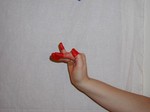Viprakīrna
Nṛttahastas - Dance hands (single and combined)
Descriptions and Meanings
9:181
(d) Svastika. The Tala Mukha hands when placed crossed at the wrists in the shape of a Svastika are termed Svastika, when they are released they are called Viprakirna.
9:177
Svastika—the Talamukha hands crossed at the wrists; but released after this they are called Viprakīrṇa.
No verse annotation
Viprakīrna (loosed): Svastika hands quickly separated. Patron deity Daksina-murti.
No verse annotation:
drawing away the end of the robe (celancala), releasing.
8:530
When Swastikamukha hasta is quickly separated, it becomes Viprakīrna hasta. Its presiding deity is Dakshinamilrti.
8:530:
This hasta is used in denoting the drawing away of the end of the robe and tossing it.
8:547-548
When two Tripataka hastas join obliquely at the elbows, then it is Viprakīrṇa hasta.
8:547-548:
This hasta denotes - armour, manipulation of hands / fingers, invoking a mantra, pardoning, and consideration.
4:1242-1243
Viprakirṇa: The hands which are in the Haṁsapakṣa Hasta are placed facing out in front of the chest and point either upwards or downwards.
2:242
When the svastika hands facing down or otherwise are separated abruptly, it is viprakīrna. (The hastas follow previous hastas to form new ones)
:878
If the two Hamsapaksas are held facing down, and then moved from . the two sides of the chest to the sides, it is Viprakirna hasta.
7:113
If the svastika hastas are quickly separated, then it is said to be viprakīrṇa.
3:482
When the same hands are separated from svastika [position] it is known as viprakirna. Some say that in viprakirna these haṁsapaksha hands are held with their tips facing upwards or downwards over the breasts and facing different directions.






